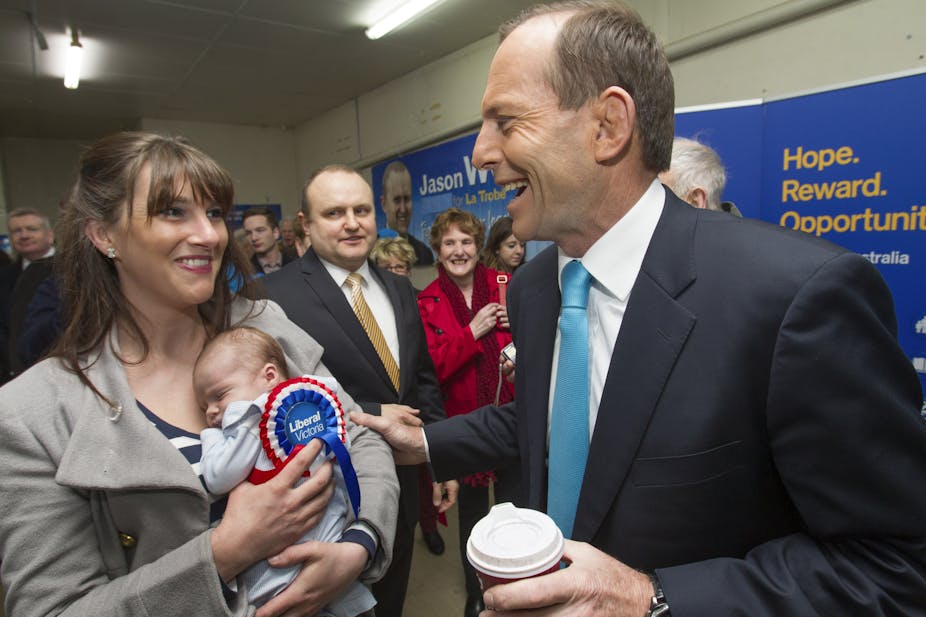Opposition leader Tony Abbott has said he hopes the recently announced Coalition paid parental leave (PPL) scheme will lead to a baby boom. Such hopes are consistent with his earlier expression of support for a larger population.
What then should we expect the demographic effects of this policy, which would take effect from July 1, 2015 and give eligible recipients replacement pay over 26 weeks, to be if it is implemented?
The evidence, both in Australia and internationally, shows it is very unlikely that to lead an Abbott baby boom.
My research with Professor Ross Guest from Griffith University has found that the fertility of Australian women whose workplace entitlements include access to paid employer-funded parental leave differs little from that of women without access to such leave.
In fact, the total fertility rate for 2011 - after the introduction of the Gillard government’s PPL scheme - was virtually identical to the pre-PPL 2010 level.
Evidence on the effects of parental leave on fertility
It is theoretically plausible that a more generous parental leave policy could increase average family sizes. However, according to a review of the international literature by Canadian sociologist Anne Gauthier, the evidence on the effects of parental leave on fertility is mixed. Some studies find small fertility-increasing effects of more generous parental or maternity benefits and others find no statistically significant effects at all.
Internationally, Norway currently has one of the most generous government-funded paid parental leave schemes, offering either 47 weeks at 100% of pay or 57 weeks at 80% of pay. Sweden also offers much longer periods of parental leave than the 26 weeks proposed by the Coalition, but has a lower ceiling for per day payments. Despite their more generous parental leave policies, the total fertility rates of these countries (1.85 for Norway and 1.91 for Sweden) are little different to Australia’s (1.88).
Timing and spacing
The introduction of the Coalition’s proposed scheme could affect the timing and spacing of children. For some prospective parents, the financial incentive to postpone births until after July 1, 2015, may be too great to ignore. We might expect a brief birth dearth followed by a temporary spike created by a catch-up of postponed births.
Eligibility for the current government PPL scheme is subject to a work test, which stipulates the primary carer must have worked for at least ten of the 13 months prior to the birth of the child.
The benefits proposed under the Coalition’s PPL scheme would provide substantial additional incentives for women to work in the lead-up to the first birth and during inter-birth intervals. Work in these periods would effectively be doubly rewarded through eligibility for government-funded PPL on top of pay from the employer. Since adequate inter-birth intervals are needed in order to allow completion of its requirements, the work test also creates incentives for family planning to ensure sufficient birth spacing.
Will every working mum be better off?
In the 2013 federal budget, it was announced that from March 1, 2014, access to PPL would be widened by allowing parents to count time from their most recent period of PPL towards the work test for a subsequent birth.
Abbott’s statement that “the eligibility for our scheme is exactly the same as the eligibility for the government’s scheme” would appear to relate to eligibility as it currently stands, as opposed to eligibility under the ALP’s scheme after March 1, 2014, since the policy makes no mention of past PPL counting towards eligibility.
It may be noted that some among the minority of women who have children after a short birth interval would be eligible for PPL under the ALP government’s policy post-2014, but ineligible for PPL under the Coalition’s proposed policy.
Therefore, while the Coalition’s policy is on average the more generous policy to working parents - especially to those on higher incomes - Abbott’s statement that “every working mum will be better off under the proposed Coalition scheme” is not strictly speaking correct when the announced widening of access to the ALP scheme is factored in.
Why hope for a baby boom?
Whether Australia needs a higher birth rate is contestable. In the short term, a higher birth rate will worsen economic dependency ratios. Over the longer term - around 50 years in the future - more favourable patterns may result. The magnitude of any very long term gains from higher birth rates could be increased by future life expectancy increases, or diminished by further increases in workforce participation in the later working ages.
The costs of an older age structure will also depend a range of other factors including on future eligibility for aged pensions. The inclusion of superannuation in the Coalition’s PPL policy should reduce such costs, particularly in view of the low levels of superannuation of mothers with more children.
Evaluation of the effects of higher birth rates therefore requires value judgements. These judgements are not only of the relative importance of shorter term economic costs and longer-term economic benefits, but also a weighing up of economic effects against the added environmentally-related costs of the greater population growth that a higher birth rate would produce.

